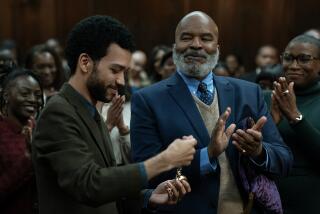Spike Lee discusses ‘Miracle at St. Anna’ (and Obama)

“NEWS flash,” says director Spike Lee, grabbing the digital voice recorder that’s on the table before him, placing it to his lips. “Spike Lee does not assume that every white person is racist. I do not feel that way. And I have not felt that way in the past. Are there some people who are like that? Yes. But I am not going to assume they are.”
Lee is sitting at a large conference table in Disney’s Touchstone offices in New York City’s Times Square, surrounded by posters of his latest film, “Miracle at St. Anna,” which opens Friday. The movie follows the grim fate of four black soldiers from the 92nd Infantry Division -- which consisted of 15,000 African American men, also known as Buffalo Soldiers -- who are caught behind enemy lines in Italy during World War II. Crouching over the table in a coiled position that suggests lack of sleep more than a readiness to pounce, Lee is fielding the question of whether he dares to think that the United States, with a population that is nearly three-quarters white, could soon vote for Barack Obama to be the first African American president.
“It’s going to happen,” the 51-year-old director says with a giddy rap of his fist on the wood table. Lee cites an emotional exchange from his film to explain his own state of anticipation: “There’s a scene between two of the leads, Derek Luke, who plays Stamps, and Michael Ealy, who plays Bishop. It’s an argument that’s been going on for years, from Booker T. Washington and W.E.B. DuBois on through Martin Luther King and Malcolm X. Bishop asks, ‘Why are we here? This is not our war.’ And Stamps says, ‘I am doing this for the future. I am doing this for my children.’
“People like Stamps have so much faith that one day America would deliver on its promise that everyone is created equal. And we are now closer to that than any other time in this country. In 2008, we are on the verge of having a black man as president. I think that that is a sign of the greatness of this country.”
Being on the cusp of a possible “seismic change” has Lee in a good mood, no sign of any soreness from the salvos he traded in May with Clint Eastwood after he criticized Eastwood’s exclusion of African American soldiers in his pair of World War II movies from 2006, “Flags of Our Fathers” and “Letters From Iwo Jima.” Eastwood went so far as to respond, “A guy like that should shut his face.” But Lee still refuses to back down: “In World War II movies, rarely do you see black men in the picture at all, never mind being heroic,” he says. “I have problems with this mythology. To this day, I still do. And if people have a problem with me because I have a problem with that, I don’t know what to say, because I am not lying.”
But now Lee can let his work do the talking, and his message comes through loud and clear, just as it did in his 1989 racially charged landmark feature “Do the Right Thing.” In one of the first scenes in “Miracle at St. Anna,” a black man watches John Wayne in “The Longest Day” on television, and whispers, “Pilgrim, we fought for this country too,” a line that Lee himself wrote into James McBride’s screenplay.
Growing up in Brooklyn, Lee loved watching movies about the Second World War, but his awareness that black people weren’t showing up on screen didn’t jibe with his own personal experience: Two of his uncles had served in the war as part of the Red Ball Express, the supply line that helped fuel Gen. George S. Patton’s march toward Germany.
“I’ve wanted to make a World War II film since I wanted to be a filmmaker,” says Lee. “Everything I have done up to this point has prepared me to make something this epic in size and scope.”
He also needed the right source material, which came along in McBride’s 2002 book, a fictionalized account of four Buffalo Soldiers that was based on McBride’s extensive research. On the heels of his 2006 commercial success, “Inside Man,” Lee enlisted McBride to write the screenplay. McBride found his director to be very demanding. “But he’s very demanding of himself,” says the writer, who adds that Lee pushed him most of all to create “multidimensional” characters, whether they were African American, Italian partisans or Nazi officers.
Production on the $45-million film began in October 2007 in Florence, Italy. Unable to secure higher-profile talent, including Terrence Howard (who had a scheduling conflict) and Wesley Snipes (who was in the middle of his troubles with the IRS), Lee settled upon four relative unknowns in Luke, Ealy, Laz Alonso and Omar Benson Miller.
Luke says he sees Lee as a “mediator of history” and was impressed by his director’s rabid commitment, to the point of putting the actors through a two-week boot camp before shooting began. The fact that the African American actors were bunked in lesser quarters than the German actors -- intended to parallel how African American soldiers were actually given worse facilities to live in than certain German POWs -- impressed upon Luke how “the enormity of this film was as enormous as the history,” he says.
Lee even shot a pivotal scene, the murder of more than 500 women, children and elderly Italians, at the actual site at Sant’Anna di Stazzema, where the Nazis had committed a massacre in 1944. “We could feel the spirits and souls while shooting,” says Lee, who emphasizes that as much as “Miracle at St. Anna” is about reclaiming African Americans’ place in history, it’s about more than that. “This film is about many different things. It’s framed in a murder mystery. It’s about the Italians, some of whom followed the fascist regime and the others who wanted democracy.”
Lee describes his prolificacy -- he turns out at least one feature every two years, along with a trail of critically acclaimed documentaries and commercial work -- as “shedding,” a jazz term. “Got to get in the woodshed. Got to keep working on the craft,” he says. He currently has three films in different states of development -- a sequel to “Inside Man,” a film about the L.A. riots, and a biopic about James Brown.
But would he be ready with his camera should Obama win his bid for the White House?
“The Obama camp has my number,” says Lee, who proudly adds that he had been flying an Obama-Biden flag outside his brownstone in the Upper East Side. But he recently had to take it down. “People were ringing the bell, thinking it was Obama headquarters,” Lee says, with a laugh that turns into a cackle of glee.
More to Read
The biggest entertainment stories
Get our big stories about Hollywood, film, television, music, arts, culture and more right in your inbox as soon as they publish.
You may occasionally receive promotional content from the Los Angeles Times.






